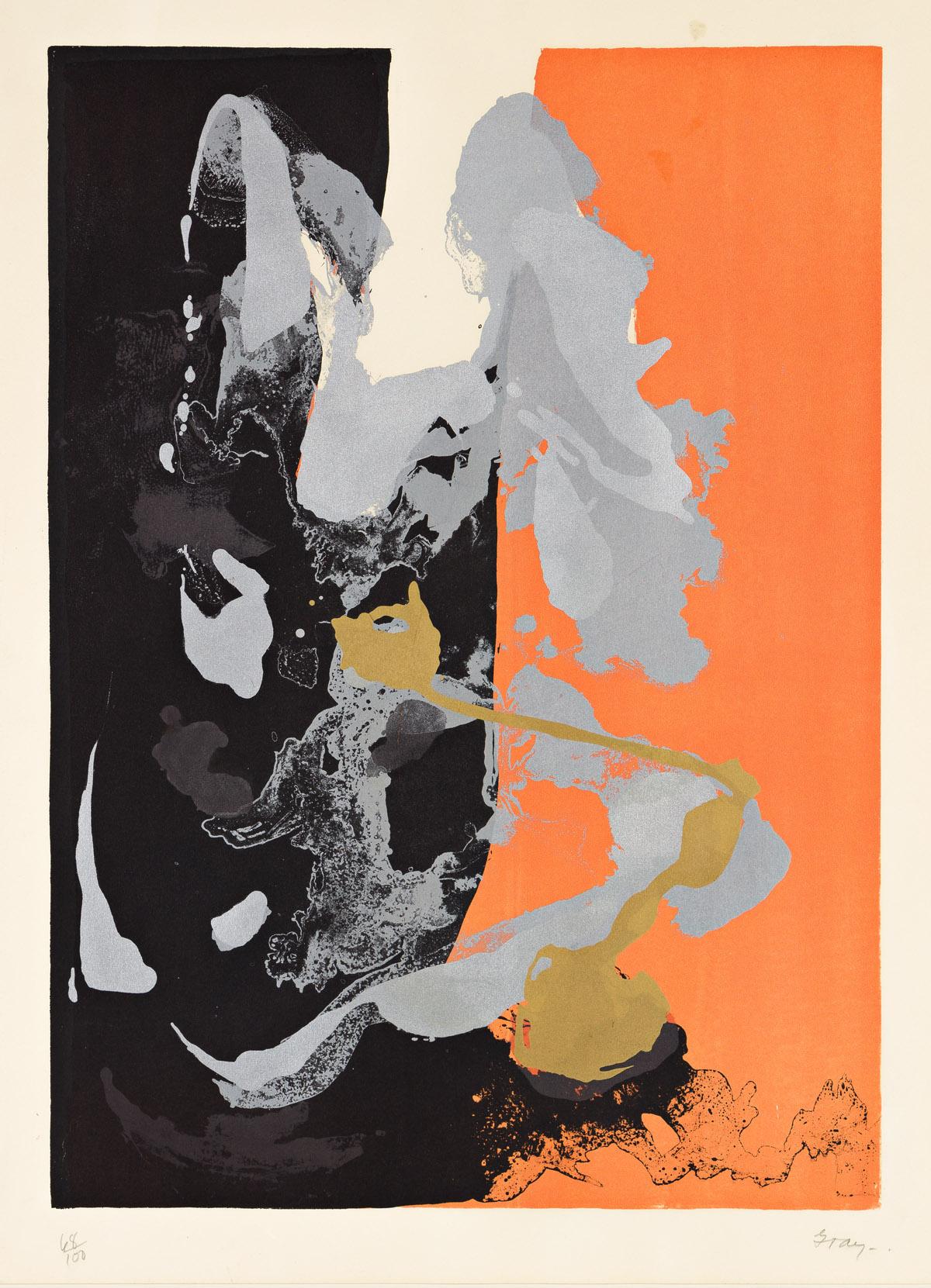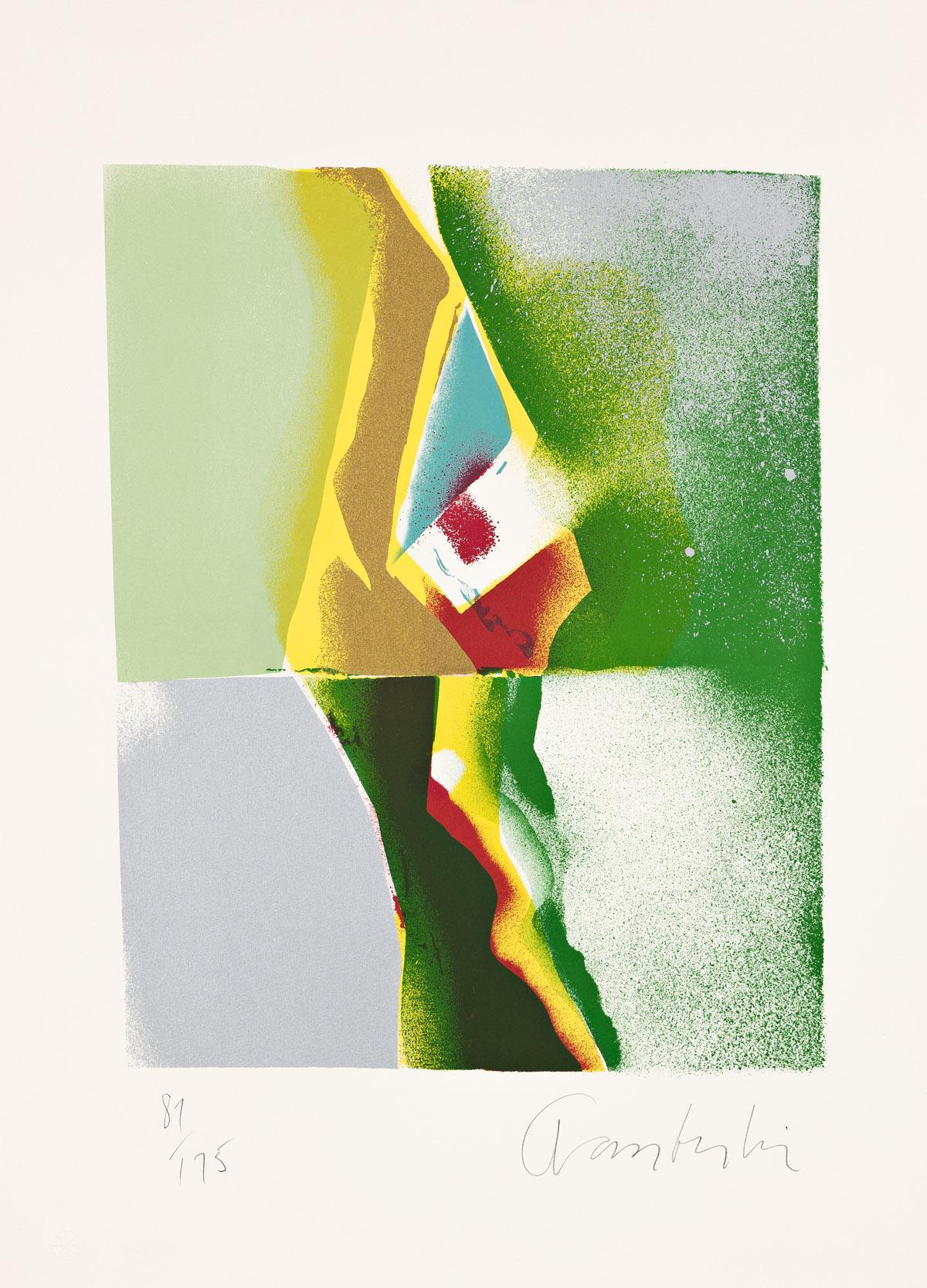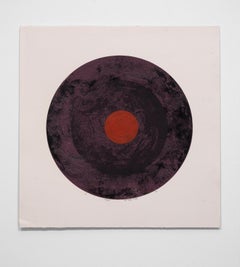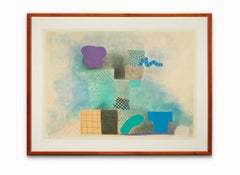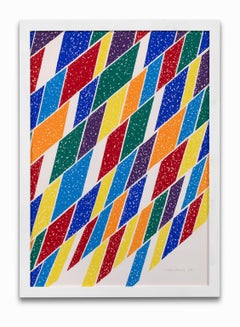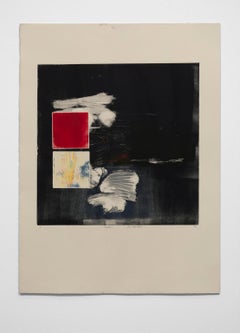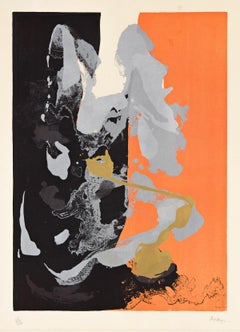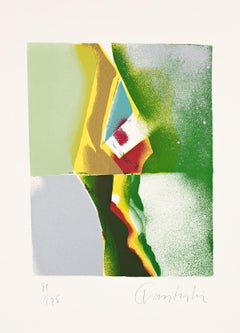Items Similar to Giuseppe Capogrossi Iconic Comb Design "Superficie 324" Serigrafia
Want more images or videos?
Request additional images or videos from the seller
1 of 12
Giuseppe CapogrossiGiuseppe Capogrossi Iconic Comb Design "Superficie 324" Serigrafia1988
1988
About the Item
"Superficie 324" is a 1988 screen print (serigraph) of a 1959 painting by Capogrossi. This is one of his famous "comb" or "fork" works that he perfected in the 1950s and continued to create for the remainder of his life. The blocks of primary red and yellow colors give a bright, joyful feel and contrast to the strong bold black that was Capogrossi's consistent color for the "combs". With no allegorical, psychological, or symbolic meanings, these structural elements could be assembled and connected in countless variations. Intricate and insistent, Capogrossi's signs determined the construction of the pictorial surface. This piece is identified along one side: Giuseppe Capogrossi By SIAE 1988 Silvio Zamorani Editor Via Saccarelli, 9 10144 Torino Italy Tel. (39)(11) 4730554 Progetto Grafico (Graphic Project): Studio Walter Benjamin. Serigrafia (Screen Print): BISI Torino.
Capogrossi was born in Rome. After obtaining a degree in law in 1923–1924, he decided to study painting with Felice Carena at Accademia di Belle Arti di Roma. In 1927 Capogrossi embarked on a formative trip to Paris together with fellow artists and acquaintances Fausto Pirandello, Corrado Cagli and Emanuele Cavalli. They worked in a figurative style characterized by pale and ethereal tones, which endowed their compositions with a mysterious, almost magical aura. The three artists were among the loose association of painters that came to be known as Scuola Romana (Roman School). In 1933 they collaborated on the "Manifesto del primordialismo plastico" (Manifesto of plastic primordialism), in which they discussed the presence of the archaic in the contemporary world. From the mid-1930s, Capogrossi adopted a darker palette, and between 1945 and 1948 his figurative tonal painting gave way to an increasingly abstract geometric style.
A decisive shift in Capogrossi's career took place in 1949, when he developed a vocabulary of irregular comb- or fork-shaped designs. Similar to mysterious lists or sequences, his paintings were immediate in their appeal yet remained hard to decode, a quality he shared with Art Informel practitioners. These abstract comb-sign paintings, usually known simply as Surfaces (Superficies), were begun in 1949 and first exhibited at the Galleria del secolo, Rome, in 1950. Soon becoming the hallmark of Capogrossi's style, the comb sign dominated his oeuvre until the end of his career.
In 1951, Capogrossi joined Mario Ballocco, Alberto Burri, and Ettore Colla in showing work at Aurora 41, Rome, an occasion that marked the debut of the group Origine (Origin, 1950–51). Primarily concerned with the promotion of abstract art, the group reacted against mainstream realist practices and advocated a simplified language meant to return art to its origins. The following year, Capogrossi joined the Movimento spaziale (Spatial movement, 1947–60), initiated by Lucio Fontana in Milan. Readily embracing the many changes affecting the country in the postwar era, especially scientific progress, the group advocated for a new spatial art that acknowledged recent inventions such as television and neon lighting.
Capogrossi's singularity was recognized both in Italy and abroad, and he took part in group exhibitions at Galerie Nina Dausset, Paris (1951); Guggenheim Museum (1953); Venice Biennale (1954, 1962); Documenta, Kassel, West Germany (1955, 1959); Carnegie International, Pittsburgh (1958, 1961); and Tate Gallery, London (1964). Capogrossi has also been the subject of numerous solo shows at institutions including the Institute of Contemporary Arts, London (1957); Leo Castelli Gallery, New York (1958); Palais des beaux-arts, Brussels (1959); and Galleria L'attico, Rome (1962). Capogrossi died on October 9, 1972, in Rome. Two years later the Galleria nazionale d'arte moderna, Rome, organized his first major posthumous retrospective.
- Creator:
- Creation Year:1988
- Dimensions:Height: 40.25 in (102.24 cm)Width: 55.25 in (140.34 cm)
- Medium:
- Movement & Style:
- Period:
- Condition:
- Gallery Location:Detroit, MI
- Reference Number:1stDibs: LU1286111560142
About the Seller
5.0
Vetted Professional Seller
Every seller passes strict standards for authenticity and reliability
Established in 2014
1stDibs seller since 2019
106 sales on 1stDibs
Typical response time: 1 to 2 days
- ShippingRetrieving quote...Shipping from: Detroit, MI
- Return Policy
Authenticity Guarantee
In the unlikely event there’s an issue with an item’s authenticity, contact us within 1 year for a full refund. DetailsMoney-Back Guarantee
If your item is not as described, is damaged in transit, or does not arrive, contact us within 7 days for a full refund. Details24-Hour Cancellation
You have a 24-hour grace period in which to reconsider your purchase, with no questions asked.Vetted Professional Sellers
Our world-class sellers must adhere to strict standards for service and quality, maintaining the integrity of our listings.Price-Match Guarantee
If you find that a seller listed the same item for a lower price elsewhere, we’ll match it.Trusted Global Delivery
Our best-in-class carrier network provides specialized shipping options worldwide, including custom delivery.More From This Seller
View AllJoyce T. Nagel Collagraph "Earthcore" Signed Dated Ltd Ed
Located in Detroit, MI
"Earthcore" is an abstract of a familiar image ... a view of earth sliced in half usually as an explanation of the many layers of spaceship earth. This print is more than its title. It is rich in its depth of color and texture. Upon close inspection there is much activity on the surface which continually adds to its visual complexity.
The name given to this print process is “Collagraph” It is made by glueing different materials to cardboard and creating a kind of collage. During the inking process the ink will rub off surfaces that are smooth or higher and stay on surfaces that hold more ink, at edge and at lower points thus creating the image. To protect the plate through the printing process it’s sealed with one or more layers of shellac. A collagraph plate is quite sensitive and will be deformed by the pressure of the printing press.
Joyce Tilley Nagel...
Category
1960s Abstract Expressionist Abstract Prints
Materials
Paper, Ink
Robert Natkin Abstract Lithograph Signed Numbered
By Robert Natkin
Located in Detroit, MI
SALE ONE WEEK ONLY
Soft pastel colors in floating smudges lay between and around lyrical abstract geometric and organic forms giving a diaphanous color and shape harmony to the work...
Category
1990s Abstract Expressionist Abstract Prints
Materials
Lithograph
Piero Dorazio Lithograph Abstract Geometric Quadrilateral Polygon
By Piero Dorazio
Located in Detroit, MI
The work is a Lithograph, not numbered, but signed and dated by the artist, Piero Dorazio. The print has an intense color field with a strong linear element being composed of quadril...
Category
1970s Abstract Expressionist Abstract Prints
Materials
Lithograph
Joyce T. Nagel Monoprint Abstract "Dropout" Signed Dated
Located in Detroit, MI
"Dropout" is one of the monoprints that Joyce Nagel so enjoyed creating. This monoprint is a one-off abstract print. The arrangement of shapes and colors p...
Category
1980s Abstract Expressionist Abstract Prints
Materials
Paper, Ink
"#24-80D Color Climb", Mixed Media Stencil Casting, Pencil Signed and Numbered
Located in Detroit, MI
"#24-80D Color Climb" is an exemplary work of Paul E. Maxwell's "stencil casting" works. This abstract but grid-like work employs a thickly textured and layered surface that has also...
Category
1980s Abstract Mixed Media
Materials
Mixed Media, Stencil
Joyce T. Nagel Print "Vegetable Forms No. 9" "1st State" Signed Dated Ltd Ed
Located in Detroit, MI
"Vegetable Forms No. 9" "1st State" is a beautiful linear design woodcut of an artichoke. What is intellectually interesting is the fractal beauty of nature found in the artichoke. A fractal is a kind of pattern that we observe often in nature and in art. Whenever you observe a series of patterns repeating over and over again, at many different scales, and where any small part resembles the whole, that’s a fractal. The Artichoke is the perfect example in that the shape of the leaves repeat themselves and they are the same shape as the fruit itself. Fractals are exciting, not only for their mathematical or conceptual representation, but also for the fact that you can visualise the math—and it’s beautiful! This print is rendered in an intense green with a light blue color to delineate the intriguing linear element of the artichoke's leaves.
Joyce Tilley Nagel...
Category
1970s Abstract Abstract Prints
Materials
Paper, Ink
You May Also Like
Night St. Maxime
By Cleve Gray
Located in New York, NY
A very good impression of this color screenprint on Rives BFK. Signed and numbered 68/100 in pencil by Gray. Dimensions with the frame are 31 x 23 inches.
Category
1980s Abstract Expressionist Abstract Prints
Materials
Color, Screen
Flashback II
By John Chamberlain
Located in New York, NY
A very good impression of this color screenprint on Rives BFK. Signed and numbered 81/175 in pencil by Chamberlain. Published by London Arts, Inc., Detroit, with the blind stamp lowe...
Category
1980s Abstract Expressionist Abstract Prints
Materials
Color, Screen
Large Abstract Expressionist Silkscreen by Michael Steiner
By Michael Steiner
Located in Long Island City, NY
Abstract expressionist print by American artist Michael Steiner, who is most commonly known for his large scale sculptures.
Tit I
Michael Steiner, American (1945)
Date: 1979
Screen...
Category
1970s Abstract Expressionist Abstract Prints
Materials
Screen
Large Abstract Expressionist Silkscreen by Michael Steiner
By Michael Steiner
Located in Long Island City, NY
Abstract expressionist print by American artist Michael Steiner, who is most commonly known for his large scale sculptures.
Oxos II
Michael Steiner, American (1945)
Date: 1979
Scre...
Category
1970s Abstract Expressionist Abstract Prints
Materials
Screen
Large Abstract Expressionist Silkscreen by Michael Steiner
By Michael Steiner
Located in Long Island City, NY
Abstract expressionist print by American artist Michael Steiner, who is most commonly known for his large scale sculptures.
Pales I
Michael Steiner, American (1945)
Date: circa 198...
Category
1970s Abstract Expressionist Abstract Prints
Materials
Screen
Large Abstract Silkscreen by Raymond Parker
By Raymond Parker
Located in Long Island City, NY
Artist: Raymond Parker, American (1922 - 1990)
Title: Untitled 14
Year: 1980
Medium: Silkscreen, signed and numbered in pencil
Edition: 70
Image Size: 31 x 36 inches
Size: 32 x 37.5 ...
Category
1980s Abstract Expressionist Abstract Prints
Materials
Screen
Recently Viewed
View AllMore Ways To Browse
Vintage Comb
Vintage Progress Lighting
The Attico
1950s Vintage Neon Signs
Neon 1930s
Walter Torino
1930s Neon Sign
Ubu Aux Baleares
Vintage Broad Axe
Vintage Frog Bank
Wan Li Great Wall Oil Painting
Wendy O Williams
Whaling Lithograph
Wifredo Lam Innocence
Wilde Meyer
Womens Mug Shots
Yaacov Agam Rainbow
Yannis Moralis
